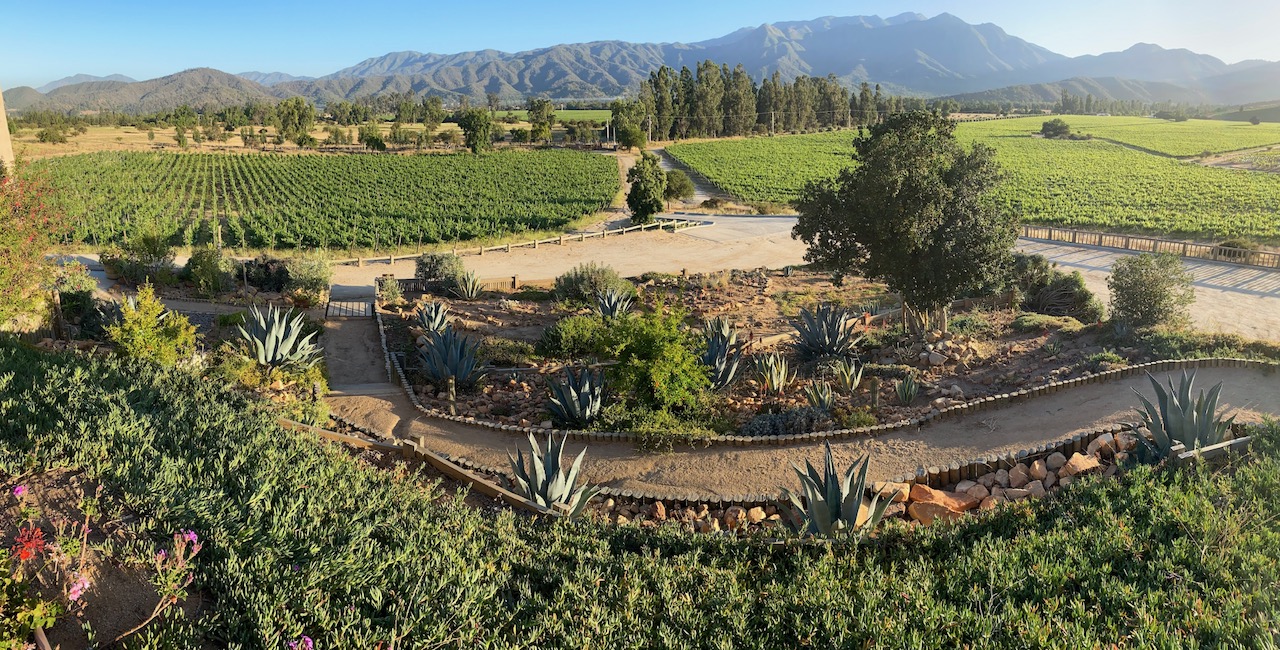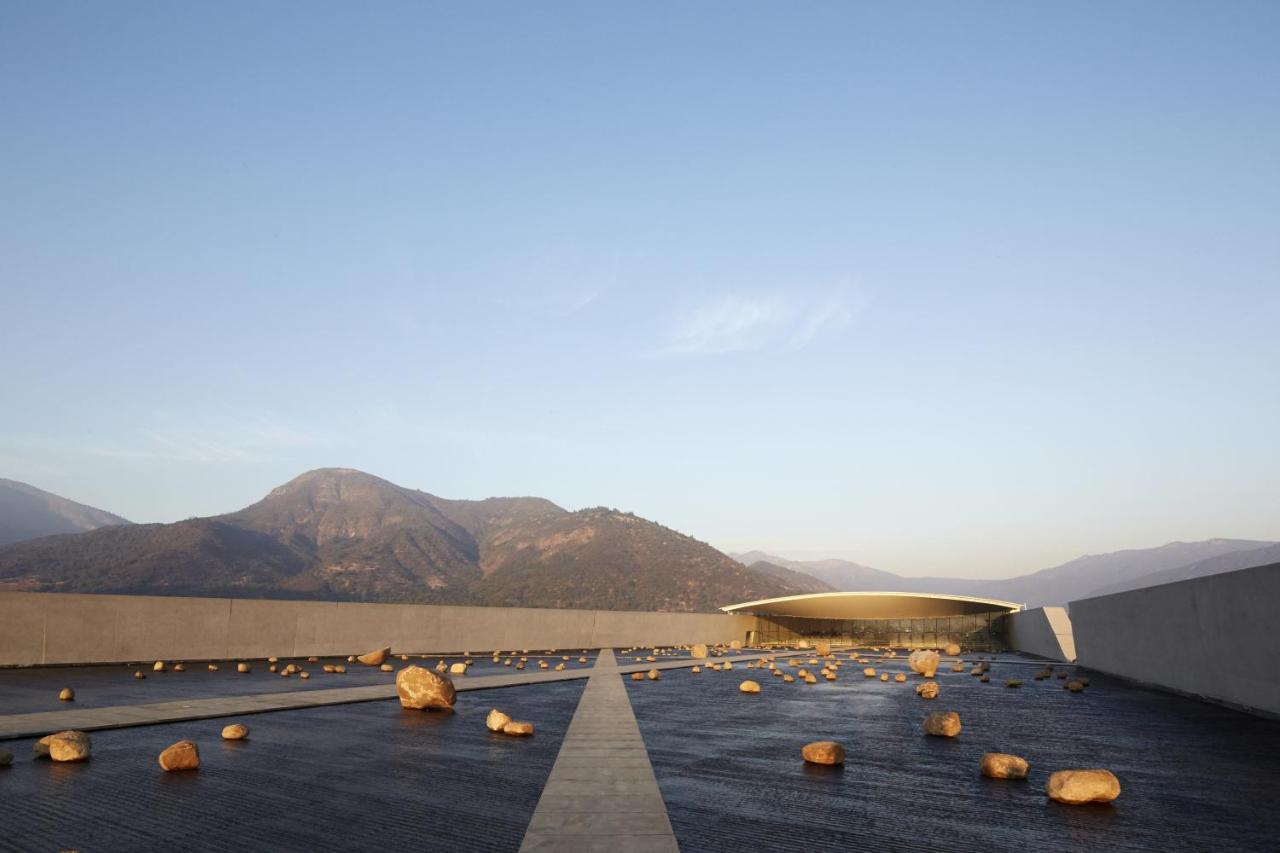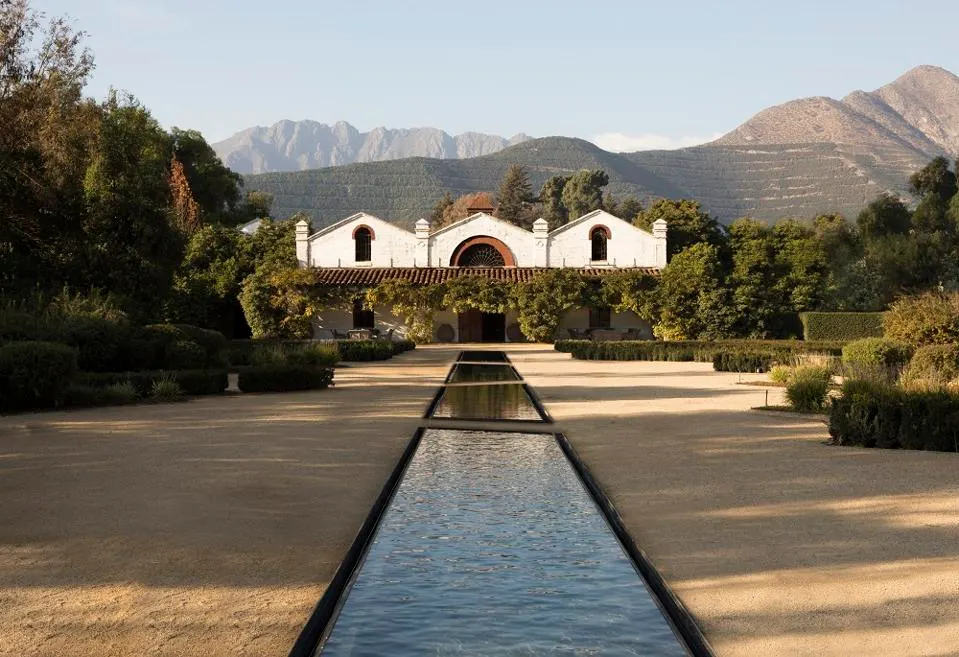September 30, 2024
The Wine Lover's Guide to Chile's Wine Valleys
It’s no secret that Chile produces some of the world’s finest wines. Nestled between the towering Andes and the vast Pacific, this narrow country enjoys ideal conditions for vine growing—sun-soaked days, cool nights, and rich, diverse landscapes. The result? A wine scene that rivals the best globally, producing exceptional bottles that reflect the soul of Chile’s unique terroirs.
Exploring Chile’s wine valleys goes beyond just tasting world-class wines—it’s a deep dive into Chilean culture, history and craftsmanship. Whether you're a wine collector in search of rare gems or a curious traveller eager for a genuine cultural immersion, Chile’s wine valleys deliver both outstanding wines and unforgettable experiences.
Here’s a look at six wine valleys we love and what makes each one a must-visit for any wine enthusiast.
Casablanca
Between Santiago and Valparaíso, the Casablanca Wine Valley is an ideal day trip or a scenic stop on your way to the coast. Though viticulture here is relatively young—only about 30 years old—the valley has quickly become a top destination for white wines.
The region’s unique microclimate, shaped by the nearby Pacific coast and the Andes, provides ideal conditions for exceptional wines. The valley’s salty air, cool breeze and heavy fog make it ideal for growing crisp whites such as Sauvignon Blanc and Chardonnay. Cool climate reds such as Pinot Noir also do well here.
Where to drink:
Villard: Thierry Villard, a native of Paris, travelled the world before settling in Chile in the mid-1980s. In 1989, he established Villard Fine Wines, becoming one of the pioneering wineries in Casablanca Valley. Today, this charming family-owned boutique winery is run by Thierry and his son Charlie, who craft their wines with love. Their Chardonnay, Sauvignon Blanc, and Pinot Noir thrive in this valley’s climate, delivering a perfect blend of warmth and quality. Plus, they’re proud members of MoVi, Chile’s movement of independent vintners, who make high-quality, private wines.
Attilio Mochi: Another gem from the MoVi family led by Angela Mochi and her husband. This Brazilian duo has mastered the art of cool-climate reds. Think Cabernet Franc, Malbec, and Grenache, alongside bold whites like Viognier and their unique Orange Wine.
Bodegas Re: After achieving so much in the wine world, why not reinvent the game? That’s exactly what legendary winemaker Pablo Morandé and his son Pablo Jr. (seventh-generation winemakers) set out to do. They create wild blends like Pinot Noir with Moscatel and Syrah with Carignan—and the results are nothing short of spectacular. They also make olive oil, wine balsamic, and fruity liqueurs, all available for tasting at their cosy emporium.
Where to stay:
La Casona at Matetic Vineyards, a charming colonial-style boutique hotel, offers the perfect retreat for relaxation and rejuvenation after a day spent exploring some of Chile’s finest organic and biodynamic wines. Each room is uniquely decorated with high ceilings, wooden furnishings, and beautiful oversized bathrooms adorned with hand-painted ceramic tiles.


Maipo
In the shadow of the Andes, about 30 kilometres from Santiago, the photogenic Maipo Valley is home to some of Chile’s finest Cabernet Sauvignon, benefitting from long sunny days and dropping evening temperatures that favour flavour development. The recently rediscovered Carménère also does well here.
Where to drink:
Almaviva: A joint venture between Chile’s Concha y Toro and France’s Baron Philippe de Rothschild, Almaviva blends French winemaking tradition with Chilean terroir. Its 2017 vintage was named Wine of the Decade by renowned critic James Suckling and it's easy to see why.
Pérez Cruz: A standout winery in Maipo Valley, Pérez Cruz showcases the very best of their red varietals. While their flagship Cabernet Sauvignon steals the spotlight, their stunning Cabernet Franc, Carménère, and Cot are equally unforgettable. With a hands-on approach and cutting-edge tech like drones to perfect the harvest timing, every vine is nurtured to deliver top-tier quality.
Antiyal: Renowned Chilean winemaker Alvaro Espinoza, along with his wife Marina Ashton, founded Chile’s first fully biodynamic winery. A pioneer in organic and biodynamic viticulture, Alvaro crafts a limited selection of exceptional reds. Visitors can stroll through the vineyard, where chickens, dogs, and diverse plants thrive in harmony with nature, before enjoying these fine wines on the rooftop of their charming cellar.
Where to stay:
Just 45 minutes from Santiago, Hotel Casa Real is an oasis nestled within a 40-hectare century-old park, recognised as one of the most beautiful and well-preserved in Chile's Central Zone, designed by French landscape architect Guillaume Renner. Built in 1880, Casa Real was lovingly converted into one of the most prestigious hotels in Chile in the mid-90s. Set within the Santa Rita Winery, it's perfect for those looking to experience Chile’s rich culture and heritage, with wine at the heart of it all. The hotel’s 16 ensuite rooms exude European glamour with soaring ceilings, classic furniture, and French doors that open onto a charming courtyard with a stone fountain.
Next to the hotel is a neo-Gothic chapel, designed by German architect Teodoro Burchard, who also designed the hotel. Dining at the Doña Paula restaurant is a highlight of the stay, offering delicious meals in a historic setting. Another must is the Museo Andino, which houses an impressive collection of around 3,000 archaeological and ethnographic pieces from the pre-Columbian cultures that once inhabited the region.


Colchagua
An icon of wine production in Chile, the Colchagua Valley is a prime destination for wine enthusiasts and a perfect weekend getaway from Santiago.
Sandwiched between the Andes Mountains and the Coastal Mountain Range, Colchagua is home to around 1,700 vineyards. The region is known for its powerhouse reds like Cabernet Sauvignon, Carménère, Syrah, and Malbec- in fact, most of the world’s Carménère comes from the Colchagua Valley. This once-lost grape was rediscovered in Chile after hiding in plain sight for years, mistakenly identified as Merlot after the phylloxera blight destroyed its original vines in France.
Recently, wineries have ventured closer to the coast, harnessing cooler temperatures to craft standout cool-climate reds. High-quality wines have received international recognition and numerous awards, establishing the Colchagua Valley as one of the leading wine-producing regions in the world.
Where to drink:
Maquis: In a valley once owned by presidents, Maquis now stands as one of the most exciting and eco-conscious wine projects around. Beyond tasting their incredible wines, you'll stroll through lush gardens and creeks as they share their commitment to sustainability and minimal environmental impact. Their passion for what they do is contagious – and the wines? Unforgettable.
Lapostolle: Originally owned by the family behind Grand Marnier, Lapostolle set out to find the world’s finest terroir – and they succeeded. Their cutting-edge five-story gravitational cellar and exceptional terroir have made Colchagua Valley a global wine hotspot. In 2008, their vintage was crowned the best in the world by Wine Spectator, and since then, their wines have consistently earned perfect scores from top critics. A stop here is simply unmissable.
Neyen: With roots dating back to 1890, Neyen’s red wine production includes harvests sourced directly from the original carménère vines brought from Bordeaux. Tucked away in Apalta, a serene sub-valley of Colchagua, Neyen – meaning "spirit" in the native Mapudungun language – focuses on one extraordinary wine: a powerful blend of Cabernet Sauvignon and Carménère. Enjoy a tasting of this unique blend in their historic celllar, built in 1890 it’s the oldest in the Apalta Valley. In rare years, they also bottle a coveted Malbec from 120-year-old vines, producing only 500 bottles. If you’re lucky enough to find it, don’t leave without one – it’s a true treasure.
Where to stay:
On the renowned estate of the Clos Apalta Winery, the Clos Apalta Residence offers a truly unique way to explore Chile’s wine country. A Relais & Chateaux hotel, it features four exclusive casitas, each named and designed after a wine produced by the vineyard. Accessible by golf car from the main house, where there is an infinity pool and dining room where chefs work their magic using produce from the hotel’s own organic garden, and a sundeck—perfect for enjoying a glass of wine at the end of the day. Guests can descend into the winery’s subterranean tasting room to learn about the role gravity plays in creating Clos Apalta’s renowned wines or explore the expansive vineyards by bike or horseback, as the Huaso (Chilean cowboys) do.


Cachapoal
Just a short drive from the massive Colchagua Valley lies the smaller but equally noteworthy Cachapoal Valley. Though lesser known, this valley shares a similar climate with its famous neighbour, making it ideal for cultivating red wines, which account for 90% of the grapes grown in the region.
The Cachapoal Valley's climate, characterised by intense, sun-soaked summers and heavy winter rains, combines with its mineral-rich soils to produce lush, full-bodied reds. The valley's unique terroir allows for the creation of wines with deep, concentrated flavours and a distinctive character. Cabernet Sauvignon and Carménère are the region’s standout varieties, thriving in the warm, fertile conditions that define this area.
Despite its smaller size, the Cachapoal Valley is gaining recognition for its exceptional red wines, offering a compelling contrast to the larger and more established wine regions of Chile. This hidden gem is increasingly attracting attention from wine enthusiasts and producers alike, drawn by its potential for crafting some of the country's most expressive and richly textured wines.
Where to drink:
Viña VIK: In 2004, Norwegian entrepreneur Alexander Vik set out to create the world’s best wine and began searching for the ideal terroir. After two years of consulting with winemakers, climatologists, geologists, and agronomists across South America, he purchased a 4,450-hectare estate in the Cachapoal Valley. The winery’s holistic approach uses cutting-edge technology to craft exceptional blends of Cabernet Sauvignon, Carménère, Syrah, Merlot, and Cabernet Franc. Visitors can also appreciate the winery’s innovative design, featuring a concrete plaza and water feature that naturally cools the underground cellar.
Tipaume: founded by French winemaker Yves Pouzet, is a beautiful family-run project located in Chile’s Cachapoal Valley. As one of many French expats contributing to Chile’s natural wine movement, Pouzet crafts two exclusive wines, both blends, using entirely natural methods. Tipaume is committed to producing wines with zero additives, embracing organic farming and sustainable practices. Every step, from the vineyard to the bottle, reflects their dedication to purity and environmental respect, resulting in authentic wines that truly express the terroir and showcase the potential of natural winemaking in Chile.
Altair: Named after one of the brightest stars in the night sky, Altair is renowned for producing some of Chile’s finest wines. Part of the San Pedro holding, Altair, along with its younger sibling Sideral, represents the pinnacle of winemaking in the high-altitude Cachapoal Andes. Both wines are Bordeaux-style blends, carefully crafted to highlight the pure expression of the region’s exceptional fruit. Altair’s meticulous approach to winemaking, combined with the unique terroir of the Alto Cachapoal, results in complex, elegant wines that have earned a place among Chile’s top labels.
Where to stay:
Vik Hotel is one of South America's most daring design hotels, combining bold architecture, breathtaking views, and a sustainable winery that produces some of Chile’s most intriguing red wines. Each room is a masterpiece, uniquely designed by Chilean and international artists. Expect anything from sleek Japanese minimalism to surreal Dalí-inspired decor or even a chic Hermès suite filled with iconic suitcases. Every room offers its own perspective of the valley, vineyards, or the stunning infinity pool that seems to disappear into the lake below. For those seeking extra luxury, the Puro Vik glass suites are nestled into the hillside, offering floor-to-ceiling windows with uninterrupted valley views. And for the ultimate indulgence, enjoy the panoramic scenery from your private outdoor bathtub—perfect for soaking in the incredible vistas.
Guests can explore the unique wine production process with guided tastings, saddle up for horseback rides through the picturesque valleys and vineyards, hike or bike the many trails that wind through and above the estate, or enjoy some pampering at the spa with a massage, facial, or body scrub using products made from grapes grown on the property.


Aconcagua
As you climb northeast out of Santiago, the terrain shifts dramatically. The rolling hills give way to rugged rocks and intense sunlight as you pass through tunnels carved into bedrock, eventually arriving in the Aconcagua Valley. This region, named after the province and the towering Aconcagua Mountain—the highest peak in the Americas—boasts its own denomination of origin.
Here, meltwater from snowcapped Aconcagua helps irrigate the vineyards, while the valley’s warm, extended growing season contributes to its success. Though small in size compared to other Chilean wine regions, Aconcagua stands out for its exceptional quality.
It’s renowned worldwide for producing high-scoring reds, including Viña Errázuriz’s acclaimed Seña wine. Smaller winemakers also thrive here, crafting unique blends with varieties like Tempranillo and other lesser-known grapes in Chile, proving that Aconcagua is indeed "small but mighty.
Where to Drink:
Errazuriz: Once the largest winery in the world, Errazuriz is a must-visit in Aconcagua. Here, they cultivate renowned reds like Cabernet Sauvignon, Carmenere, and Syrah, along with exceptional whites from the coastal side of the valley. Errazuriz wines gained legendary status after the famous Berlin Tasting, a blind competition where they stood alongside prestigious French and Italian wines, elevating Chile's reputation as a fine wine producer on the global stage.
Flaherty: Californians Ed Flaherty and Jen Hoover came to Chile for a harvest season—and never looked back. A true boutique vineyard, Flaherty produces a limited run of just 40,000 bottles, growing their own grapes in Aconcagua and the Maule Valley. Their signature blend, Flaherty, captures the essence of ripe fruit, showcasing the classic flavours of Aconcagua. Visitors can join them for a unique lunch experience, where delicious food, heartfelt stories, and exceptional wine come together, making you feel like part of the family.
Von Siebenthal: Mauro Von Siebenthal arrived from Switzerland over 20 years ago, fueled by a passionate dream to create his own wine. Together with his wife, Sole Latorre, they invite you to explore their stunning property, where robust reds thrive, despite the cool coastal breeze that sweeps in each afternoon. Not one to follow the norm, Mauro also challenges convention by cultivating a small parcel of the complex Viognier, which matures for 12 months in barrels before its limited release. A visit here is a must for any wine lover.


Maule
The Maule Valley, located around four hours south of Santiago, is experiencing a revival, thanks to the resurgence of a grape known locally as uva País. Historically used for table wine or the rustic chicha, this grape is now being embraced by local winemakers, who are using it to reclaim an important part of Chile’s winemaking heritage.
Maule is home to some of the oldest vines in the country, with ancient bush vines as thick as tree trunks. The valley is diverse, with three distinct growing sectors where varieties like Carignan, País, and others thrive through dry farming.
The region is also steeped in Chilean huaso culture; it’s not uncommon to encounter huasos on horseback, wearing traditional wide-brimmed chupallas, as they share the road with cars. What makes Maule special is that it still has a laid-back, artisanal vibe that sets it apart from other valleys. This creates a perfect mix with the modern wineries of Colchagua, Maipo, and beyond in multi-day programs, giving visitors an authentic and memorable wine experience.
Where to drink:
Gillmore Winery: A family-run estate founded in 1990 by Francisco Gillmore located in the heart of the Loncomilla Valley. Francisco was a visionary who sought a unique terroir for a high-end wine project, and he discovered ancient, dry-farmed vines that produced grapes of exceptional quality. Today, the winery is managed by his daughter Daniella and her husband, the renowned winemaker Andrés Sánchez, a founding member of MoVI. Their philosophy is to craft signature wines that reflect the family’s hands-on approach, blending tradition with innovation. Each bottle showcases the rich aromas, concentrated flavours, and unique character of the Loncomilla Valley.
Huaso de Sauzal: A shining example of Chile's winemaking heritage, this winery boasts centuries-old vineyards and heritage varieties like the País grape. Located in the historic region of Sauzal, the winery preserves the traditional winemaking culture, with vines that date back over 300 years. Renán Cancino, the man behind the project, is deeply committed to keeping this legacy alive by cultivating the land using horses and ploughing the fields as it was done in the past, ensuring that every step of the process is as traditional as possible. Beyond winemaking, Renán is passionate about elevating his town and its people. He has transformed Huaso de Sauzal into a hub for wine tourism and cultural exchange, inviting visitors to experience the creative process behind crafting great Chilean wine. Through these efforts, the winery not only produces remarkable natural wines but also fosters a deeper appreciation for the region's history and craftsmanship.
Erasmo de caliboro: This boutique organic vineyard is owned by Italian wine royalty, Count Francesco Marone Cinzano. In 2005, he restored a historic winery, blending tradition with modern Italian winemaking techniques. Today, Viña La Reserva de Caliboro produces a select range of handcrafted red blends, drawing from Mediterranean, Bordeaux, and native grape varieties, along with a rare late-harvest Torontel. This fusion of old-world expertise and cutting-edge practices results in premium wines that reflect both the heritage of one of Italy's great winemaking families and the unique terroir of Maule.
Where to stay:
Casa Bouchon is a charming boutique hotel set within the historic Mingre ranch in Chile's Maule Valley, surrounded by vineyards and native vegetation. This 1,000-hectare property beautifully blends old-world charm with modern comfort. The centrepiece is a 150-year-old adobe manor house, thoughtfully restored to maintain its authentic character while offering contemporary amenities.
At Casa Bouchon, everything revolves around wine. With 130 years and four generations of winemaking heritage, the experience here invites guests to explore the vineyards, admire the historic barrel room, and savour exceptional wines right at their source.


